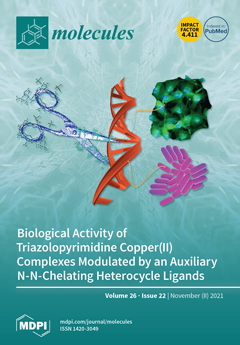Natural phenolic products from herbal medicines and dietary plants constitute the main source of lead compounds for the development of the new drug. 4,4-Dimethylcurcumin (
DMCU) is a synthetic curcumin derivative and exhibits anticancer activities against breast, colon, lung, and liver cancers.
[...] Read more.
Natural phenolic products from herbal medicines and dietary plants constitute the main source of lead compounds for the development of the new drug. 4,4-Dimethylcurcumin (
DMCU) is a synthetic curcumin derivative and exhibits anticancer activities against breast, colon, lung, and liver cancers. However, further development of
DMCU is limited by unfavorable compound properties such as very low aqueous solubility and moderate stability. To increase its solubility, we installed either or both of the ethylene-carbonate-linked L-valine side chains to
DMCU phenolic groups and produced targeted
1-
trifluoroacetic acid (
1-TFA) and
2-
trifluoroacetic acid (
2-TFA) derivatives. The terminus L-valine of ethylene-carbonate-linked side chain is known to be a L-type amino acid transporter 1 (LAT1) recognition element and therefore, these two derivatives were expected to readily enter into LAT1-expressing cancer cells. In practice,
1-TFA or
2-TFA were synthesized from
DMCU in four steps with 34–48% overall yield. Based on the corresponding LC-MS analysis, water solubility of
DMCU,
1-TFA, and
2-TFA at room temperature (25 ± 1 °C) were 0.018, 249.7, and 375.8 mg/mL, respectively, indicating >10,000-fold higher solubility of
1-TFA and
2-TFA than
DMCU. Importantly, anti-proliferative assay demonstrated that
2-TFA is a potent anti-cancer agent against LAT1-expressing lung cancer cells NCI-H460, NCI-H358, and A549 cells due to its high intracellular uptake compared to
DMCU and
1-TFA. In this study, we logically designed and synthesized the targeted compounds, established the LC-MS analytical methods for evaluations of drug solubility and intracellular uptake levels, and showed improved solubility and anti-cancer activities of
2-TFA. Our results provide a strategical direction for the future development of curcuminoid-like phenolic compounds.
Full article






